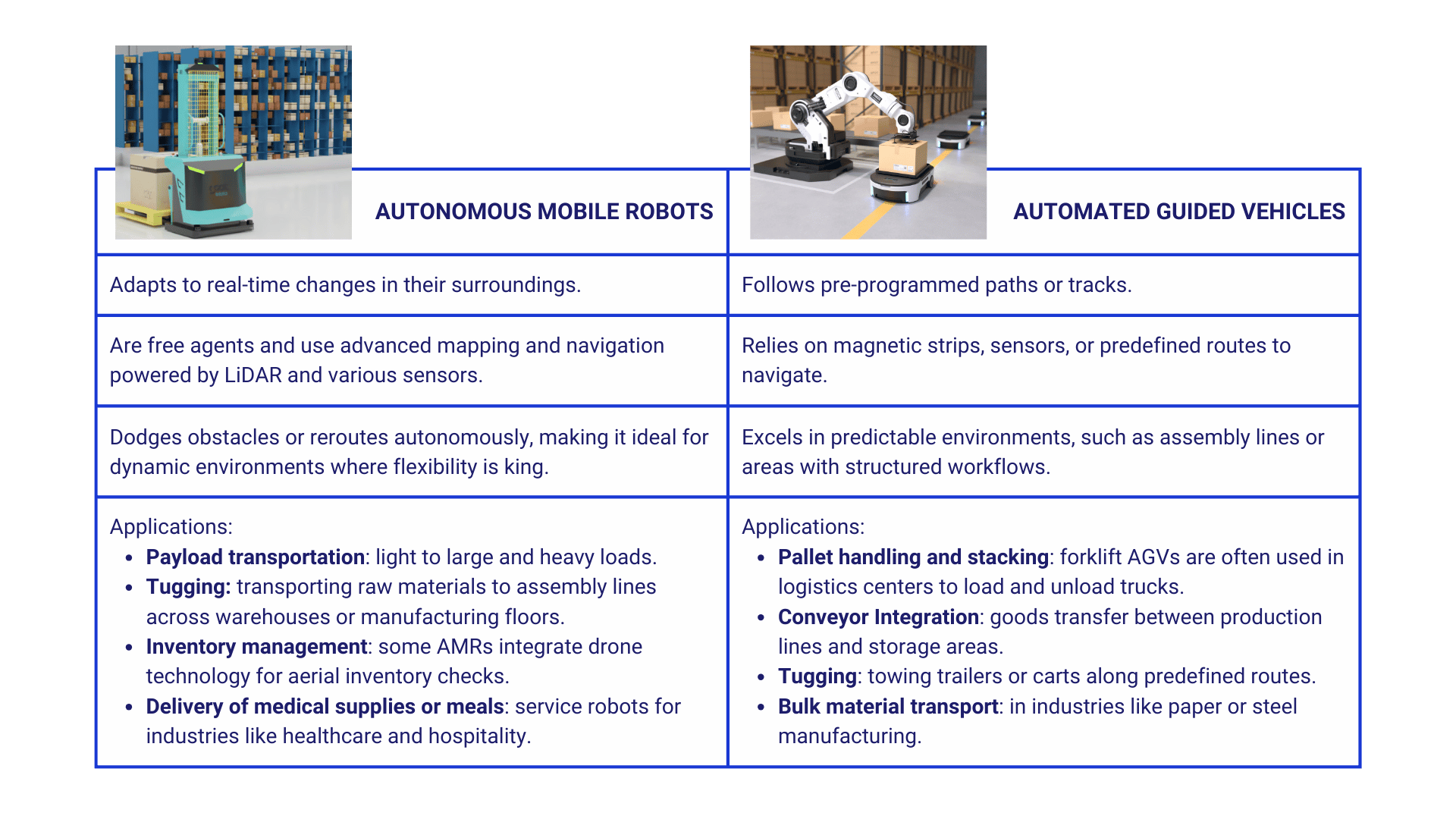AMRs vs. AGVs: Which Material Handling Robot Do You Need?
Is your material handling in hot water?
Does it create employee burnout, missed deadlines, and bleeding profits?
Have you decided to automate, but cannot separate what from whom?
Chin up. We got brilliant news.
This article dissects the differences between autonomous mobile robots (AMRs) and automated guided vehicles (AGVs). The two solutions are ideal for skipping frequent mistakes and supporting reliable warehouse automation and agile manufacturing logistics.
The insight will help you choose the right material handling robot for your operations.
Let’s begin.
AMRs vs. AGVs: How to Tell Them Apart
AMRs and AGVs are competing players in the robotics field. But each shines in different roles.
To truly understand their differences, it’s helpful to explore their specific applications and how they excel in different tasks. Here’s a breakdown of each technology:
Table 1. Differences between AMRs and AGVs (source: Verdusco Automation).
A pharmaceutical facility can see operational efficiency skyrocket with AMRs because they adjust to fluctuating demands in inventory transport. Meanwhile, an automotive assembly plant benefits from AGVs due to their precise, repetitive delivery of parts.
In e-commerce warehouses, shelf-stocking AMRs retrieve and deliver items to packing stations, speeding up order fulfillment. While in a food and beverage plant, ingredient transport from storage to production areas via AGVs ensures a steady supply chain.
Asking, “Is my process dynamic or static?” It’s crucial to land the right material handling robot for your warehouse automation or manufacturing logistics project.
Which Technology Wins for Warehouse Automation and Manufacturing Logistics?
For dynamic environments such as e-commerce warehouses or fast-paced manufacturing plants, AMRs are the ideal fit. Their adaptability allows you to:
➔ Customize material transport.
➔ Reduce downtime.
➔ Ensure continuous operations.
Look at CabraMove’s AMRs. They can reroute around obstacles, optimizing material flow 24/7.
On the other hand, predictable, repetitive tasks (like moving pallets along fixed routes) benefit from AGVs’ reliable performance.
The final choice will always boil down to your operational needs, space, and workflow complexity.
Robotic Material Handling ROI: AMRs vs. AGVs
We reached the point where the rubber meets the road.
You are about to see if the buzz about AMRs and AGVs is real.
First, see a typical robotic material handling ROI timeframe:
Fig. 1. Typical ROI breakdown for AMR and AGV adoption.
Now, let’s present you with an analysis for each technology.
Why AMRs Are a Smart Investment
Do you use manual labor to pick and place parts from the conveyor to the dunnage or box for shipping?
Your workers are most likely placing a part on the line every 20 seconds. That’s 180 parts per hour or 1,440 parts per shift.
Though impressive, repetitive handling, fatigue, or insufficient ergonomics make your workers occasionally scratch parts while transferring them.
Considering an average damage rate of 3% and a cost per part of $100, you see around 43 damaged parts per shift (1,440 x 3%), which mounts to $4,300 in damaged parts losses per shift (43 x $100). Not a good indicator to have.
Here’s how AMRs boost your productivity and profits:
Table 2. Before and after savings from AMRs deployment (source: Verdusco Automation).
You can also increment pick-and-place speed to twice or three times faster.
The Cost-Effectiveness of AGVs
As mentioned before, AGVs excel at repetitive and monotonous tasks.
Picture an automotive parts manufacturer responsible for assembling 1,000 parts daily. Each part costs $200. The company faces persistent challenges in manual forklift operations to transport components between storage areas and assembly lines.
With manual forklift operations:
Transport takes an average of 8 minutes (4 minutes to transport parts and 4 minutes to return the forklift). But operators often paused for rest or were unavailable, creating inefficiencies during peak production hours.
Mishandling parts while loading and unloading accounted for 2% of damaged components per shift, translating to 18 damaged parts per shift, which represents $3,600 in losses.
How implementing forklift AGVs changes the story?
See the comparison below.
Table 3. Before and after savings from AGV deployment (source: Verdusco Automation).
Conclusion
The choice between AMRs and AGVs isn’t a coin toss. It’s a strategic decision that impacts your bottom line. You now have the basic knowledge to tell them apart, to know which one fits your specific needs.
But that’s only half the battle.
Partnering with the right automation expert to ensure seamless integration, ongoing support, and maximize your ROI comes next.
Verdusco Automation is your trusted partner in navigating the ever-changing world of robotics.
Here are three ways we can help you:
➔ AMR or AGV Integration: We implement tailored robotics solutions for steady and dynamic environments.
➔ Robotics Consulting: We design and implement the right robotics solutions for your business.
➔ Maintenance and Support: We perform system upgrades and the foreseeable actions to keep the material handling robots up and running.
Contact us today at https://www.verduscoautomation.com/contact
Let’s optimize your operations!







